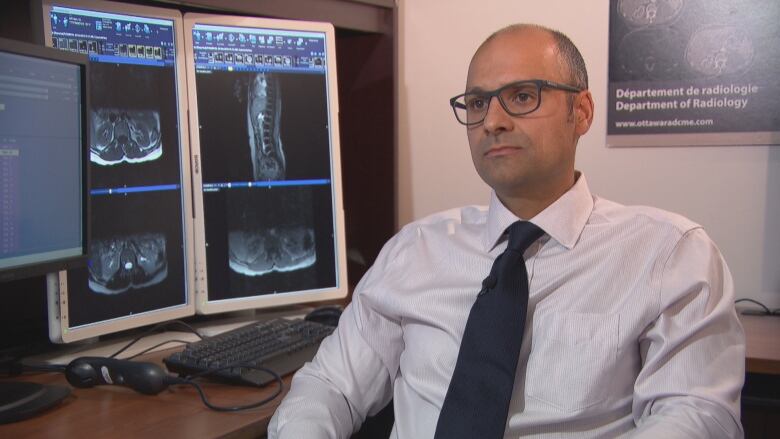Drug given to enhance MRI images under scrutiny over side-effects
Health Canada says gadolinium can sometimes build up in the brain, but balks at calling it harmful

Wanda Milley's voice breaks with emotion as she talks about the self-imposed exile she's lived in for the past four years.
"It broke my heart that I realized I've allowed this to stop me from living, from doing things with my daughter, my family. It was an eye-opener," she said.
Strange things began happening to Milley's body in April 2015 after she underwent her seventh MRI, which had been used in the diagnosis, treatment and follow-up of abrain tumour.
For all seven of the scans, she had been injected with agadolinium-based contrast agent (GBCA), a dye used to enhance the images andgivean improved picture of what is happening inside a person's body. But it was only after that last MRI thatred blotches appeared, first on her legs and then her chest, back and arms.
They were painful, burning and unsightly,keeping her largely houseboundat her home in Fort Saskatchewan, Alta.
A brain fog that she initially attributed to the tumour also continued to worsen. And there were ongoing issues with balance, hand-eye co-ordination and headaches.
None of it could be explained to her satisfaction, she said, with doctors brushing it off.
Online searches led her to believe the MRI dye might be responsible, aftershe discoveredmany others were posting their own experiences, detailingsimilar side-effects.
Gadolinium implicated in hundreds of cases
Gadolinium-based dyes arecommonly used in MRI imaging, but doctors and regulators are at a loss to explain how it may be affecting some patients, such as Milley.
Products containing the rare earth element have been licensed for use since the 1980s. Wheninjected into a patient's body prior to a scan, the substance helps to sharpen visualization ofinternal organs, tissue and blood vessels.
Gadolinium alone is toxic to humans, but in GBCAs, the element is bonded with other substances, which the bodyexpels within 24 to 36 hours after the injection, largely through urination.
But there is a growing body of evidence suggesting that in some rare cases, the metal stays and accumulates in the body. And the risk of it accumulating in patients has only been recognized by doctors in recent years, after a 2015 study found residual gadolinium in the brains of patients who underwentmultiple contrast-enhanced MRIs.
"That has been subsequently confirmed on numerous followup imaging studies, and also on animal and human autopsy studies, which have confirmed that small amounts of gadolinium are retained in certain structures within the brain, as well as in other parts of the body, including the skin, the bone and most recently in the liver," saidDr. Nicola Schieda, a radiologist at the Ottawa Hospital who authoredclinical practice guidelines around gadolinium for the Canadian Association of Radiologists.

Since 1991, there have been nearly 1,500 reports in Canada of adverse events in patients who have been injected with the substance. Many are similar to those experienced by Wanda Milley, such asburning red lesionsthat cover thebody, pain in the joints, fatigue and balance issues.
The medical community, however, is not ready to draw a link between those symptomsand the buildup of gadolinium in the body.
"What we don't know is what symptoms relate to patients who have gadolinium deposition, and whether or not the symptoms that these patients are reporting or experiencing are caused by the gadolinium deposition," said Schieda.
The science around gadolinium buildup, he said, is "about as murky as it gets."
New warnings, stronger guidelines
Health Canada first looked at the risk of gadolinium buildup in the brain and nervous system in 2016. A safety review found that gadolinium does accumulate in the brains of some patients,however, the agency said it could not find a link between that buildup and the medical issues some patients had complained about.
But new evidence collected by the European Medicines Agency, manufacturers and scientific journals emerged,and Health Canada conducted a second review, whichled to new guidelines and warnings for health professionals in 2017.
Based on the latest research, Health Canada advises:
- Use gadolinium-based dyes only when necessary.
- Use the lowest effective dose.
- Assess risks and benefits with patients before administering repeated doses.
While Schieda acknowledges there are issues around GBCAs, he maintains the use of gadolinium-based dyes is safe and beneficial formost patients. Even with close to 1,500 reports of patient problems,that still represents a small number compared with the millions of MRIs administered in Canada each year, he said.
"We do not have any scientific confirmation that the retained gadolinium which has been proven on imaging or pathological studies is toxic to neural tissues or other human tissues," he said.
But Schieda also notes there is also no evidence that GBCAsare not harmful, sayingthat the concerns ultimately point to the need for more research.
The U.S. Food and Drug Administration has also issued guidelines, ultimately concludingthat "the benefit of all approved GBCAs continues to outweigh any potential risks."
Frustrated patients turn to Facebook, Google and lawsuits
Left without a conclusive diagnosis or any sense of what they can do, patients who experience side-effects following gadolinium-based injections are turning to the internet and forming support groups on Facebook and other platforms.
Thousands of people have taken to those online groups to share their symptoms, fears and anger at a medical community that many say isn't doing enough to acknowledge their issues.
More than a dozen U.S. law firms have also set up websites to recruit patients for a potential class-action lawsuit.

As for Milley, shesaid she grew increasingly frustrated after being told by dermatologists that the red blotcheson her body were caused by psoriasis, a common skin condition.
"I just wished there was more information for me and others who might be experiencing similar things so that we have a better understanding of what's happening and that we would have a plan as to what we can do to help resolve this," she said.
Like many in the online support groups,Milley has turned to alternative health practitioners for answers and potential treatments. She said she's been tested for heavy metals three timesand was told by naturopaths there is a buildup of gadoliniumand other metals in her body.
"It's in my body,and it goes into your organs and into your bones," saidMilley. "How do we get it out?"
Lefttrying to decide what to do next, Milley said she feels abandoned by the traditional medical communityand is considering the treatments suggested on the online groups, like controversial chelation therapy.
"I feel alone in this," she said. "And it's frustrating."
With files from Raffy Boudjikanian












_(720p).jpg)


 OFFICIAL HD MUSIC VIDEO.jpg)
.jpg)



























































































